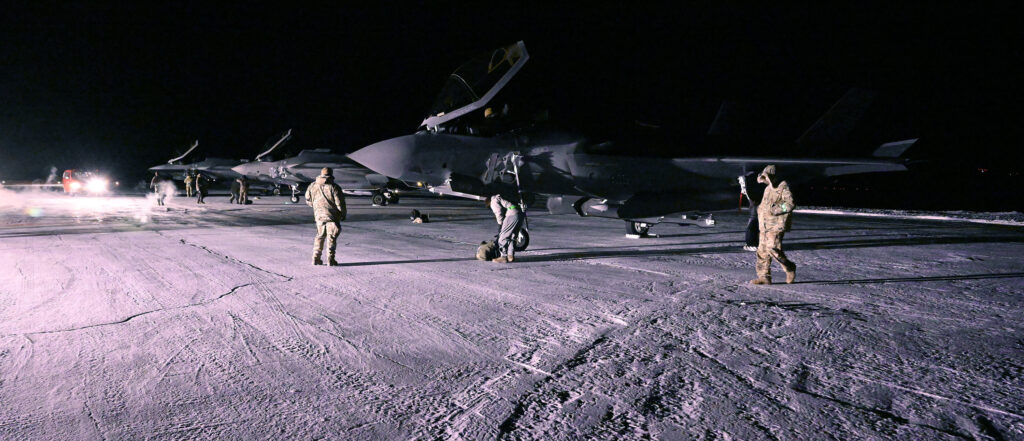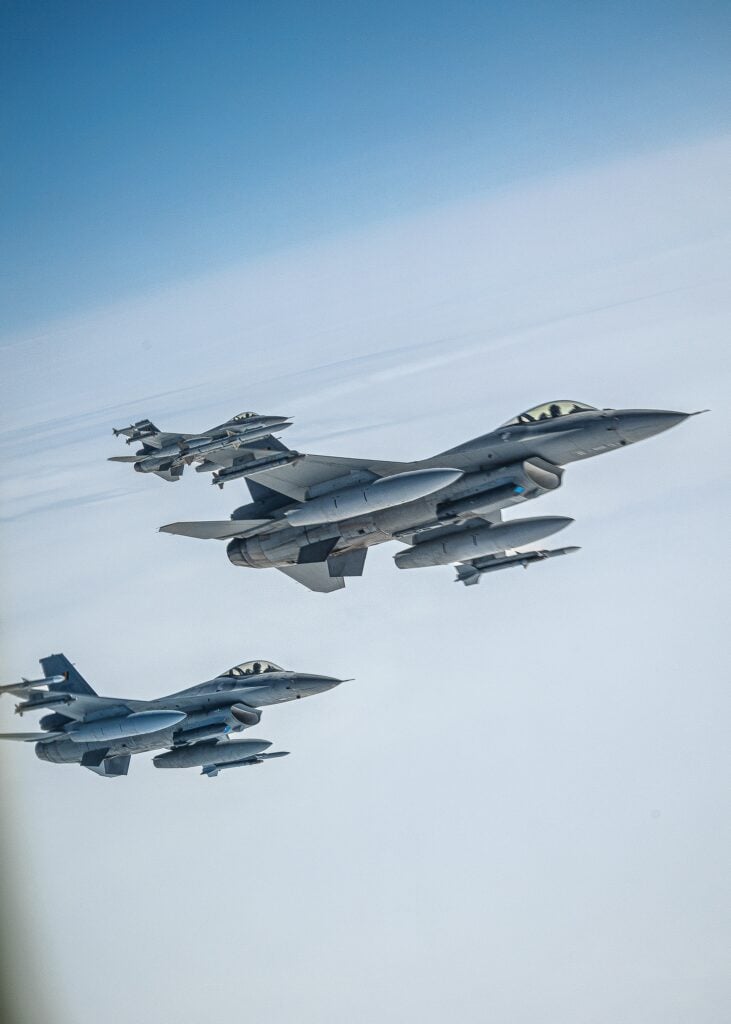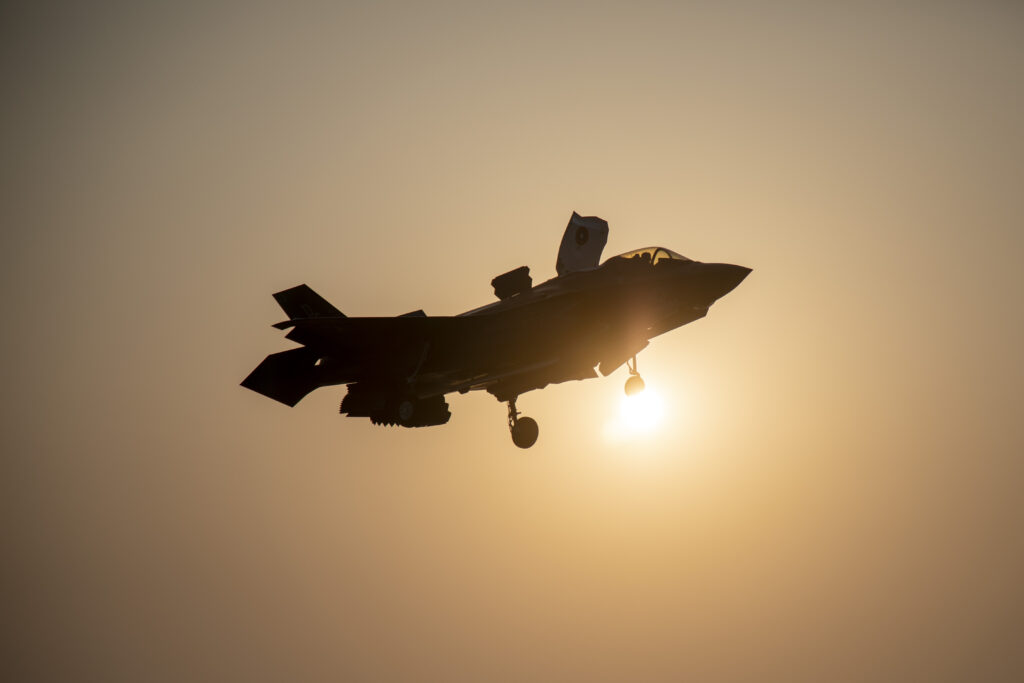In this Q&A with Gen. (ret) Jeff “Cobra” Harrigian, vice president of strategic campaigns for Lockheed Martin, who retired from the Air Force in July 2022 as commander, US Air Forces in Europe, US Air Forces Africa, and Allied Air Command, we discuss the threats facing Europe today and the solutions needed to stay ahead of these threats.
Breaking Defense: You were USAFE commander at Ramstein Air Base in Germany as recently as July 2022, so your observations about Russia’s war on Ukraine and the posture of US and European air forces are relatively fresh. What are your thoughts?

General Jeffrey L. Harrigian, Vice President, Strategic Campaigns, Lockheed Martin.
Harrigian: It first begins with keeping the teams aligned. You have nations with shared values that need to stay together and continue to find solutions for information sharing — making sure that collectively they understand the environment, the threat, and how it is evolving.
Next is ensuring that we can not only connect the platforms but are also able to command and control and battle manage them appropriately. Looking at this through a platform and air lens, that means they have the necessary interoperability to seamlessly operate across domains and get information off those platforms, whether they are fourth or fifth-gen aircraft.
As the threats continue to evolve, it is important to collectively leverage advanced avionics and technologies for situational awareness. Finding, fixing, tracking, and targeting all have to come together to be able to execute the mission.
As you look at everything from ISR platforms to fighters to tankers, even mobility and our C-130s and the interoperability that is occurring across Europe, there are a lot of moving parts that run from the platforms to how they’re connected to how you train together that have to come together to generate the deterrence value that is required as this environment continues to be dynamic, complex, and changing.
This is going to be a challenge for all the nations as we work together to find the right balance. Clearly, there is a recognition that we’ve got to modernize and to buy smart risk over time. That means considering the balance between going after exquisite, expensive technology versus mature systems that are readily available on the market today, which are particularly needed as the threats continue to evolve.
I think that’ll be not only the responsibility of the Ministries of Defense to have that discussion clearly at the political level, but also for industry to be a key part of how we work together by offering proven solutions and a vision for the future of 21st Century Security where capabilities can be modernized, spiraled in, and done in an agile way.
That will clearly be challenging from an economic perspective. It’s a matter of seeing the vision out in front while at the same time being ready for today. That’s not an easy balance for anybody, for any nation, particularly recognizing where the stakes are today and where they could be in the future.
It is important that we’re able to partner across industry, understand where the nations are, and offer integrated, tailored solutions in a timely fashion. That’s going to be critical as the environment continues to evolve.
Breaking Defense: Your point about filling conventional stockpiles while developing advanced concepts is well taken. Can you provide an example of how Lockheed Martin is doing that?
Harrigian: The F-35 from an avionics perspective is a good example of a capability that’s matured. As you look across Europe, we’ve been able to seamlessly integrate it into not only what I call the ‘classic missions’ that are performed from an air superiority perspective, but also able to integrate it into things like integrated air and missile defense where we’re having to work it across multiple domains.
We are working closely with the nations to understand what is needed from both a weapons perspective and the next-gen avionics that will be required because we have to be able to grow the capability over time and find that right balance. There will be dollars required to make that all happen, so we’ve got to do it as a team that leverages the capabilities that are present today while looking to the future.

Pilots and ground crew prepare F-35A aircraft deployed to Thule Air Base, Greenland, to take off on sorties during Operation NOBLE DEFENDER 23-2.1 Jan. 16, 2023. Approximately 225 U.S. and Canadian personnel from multiple locations across both countries are supporting the joint exercise. (Department of Defense photo by Master Sgt. Benjamin Wiseman)
Breaking Defense: In your prior position you coordinated frequently with air chiefs across Europe. What did they have to say on collaborating for all-domain operations?
Harrigian: In order to do multi-domain ops, you’ve got to have buy-in across the NATO organization. There are a lot of countries with different capabilities, so the opportunity to work with like-minded leaders that understood what they could bring to multi-domain ops was an important part of what I’ll call the ‘trust and confidence’ that was built over time.
We recognized that we have this capability and while it may not be the high-end exquisite capabilities that we intend to have in the longer term, here’s what we can do today to plug into the operations that are ongoing. A great example is F-16s.
As you look across Europe and the number of F-16s that were out there originally from Belgium, Denmark, Poland and others, those still played an important role in how we pulled together an all-domain capability that was required to execute deterrent operations such as air policing or demonstrating an offensive capability should that be required.
For us across the air component, as you digest and decompose this, it is about making sure that we’re interoperable from not only the tactics, techniques and procedures, but ultimately in being able to share data appropriately to ensure we collectively have a deep understanding of the environment and what’s needed for the mission ahead.
As you can imagine, if you’ve got aircraft from multiple nations and they can’t share data then they are just talking to each other over the radio. From a commander’s perspective, there is a certain amount of risk there because you do not want a decision to get made because somebody didn’t have all the data.
As we started to introduce F-35s into Europe with the Norwegians, Italians and Dutch, we had the ability to share data not only amongst those airplanes but could also push that data out across Link 16 to basically everybody that was on Link 16 through all domains. That was a force multiplier.
Now you start to recognize the power of what that type of capability brings, not just to the air component, but to the joint force. That was the huge leap in understanding the power of connecting and being interoperable with shared understanding to facilitate faster decision-making and agility as a joint force to stay ahead of the adversary.
And while we are still learning that, to be clear, this is a journey we’re on. This is not something that you flip the switch and suddenly this all comes together. It’s been an opportunity to explore and better understand how we do that collectively as a team because that’s truly the power of multi-domain operations.

Three Belgium F-16s fly in formation over the Arctic Circle, June 7, 2023, during The Arctic Challenge Exercise, a live fly exercise that serves to advance arctic security initiatives and enhance interoperability in the increasingly dynamic and contested region (Photo by Master Sgt. Andrew Sinclair)
Breaking Defense: What about lessons learned so far in Ukraine?
Harrigian: There were some good lessons that came over the course of the last two years about information sharing and the desire to continue that because it remains critical to sustaining our shared understanding of the environment. That would be job one for us as we go forward.
The other piece that they’ll continue to reinforce is the requirement to be interoperable. I’m going to go back to the F-35 because what we found is that the air chiefs recognize the power of getting information off that airplane and then sharing it across domains.
I would offer that that’s been a driver in nations moving toward the F-35. As you’ve seen, there have been several nations over the course of the last several months that have decided to go down the path of the F-35 because of this recognition.
As we go forward, the interoperability piece of being able to share not only data but also parts and weapons is going to be an important element of how we stay together as a team that is operating together across the vast area of Europe — not only to execute their defensive missions at home, but also to deter by demonstrating capabilities beyond just being defensive.
That goes back to making sure we have the right capabilities and that as we work and partner with the US we are staying together and moving forward so that the whole team, to the extent possible, has relatively similar capabilities such that we are able to almost seamlessly move the team or teammates to be able to contribute to the mission set.

A U.S. Marine Corps F-35B prepares to land on the amphibious assault ship USS Makin Island (LHD 8), March 31, 2023. The 13th MEU is embarked with the Makin Island Amphibious Ready Group, comprising the Makin Island and the amphibious transport dock ships USS John P. Murtha (LPD 26) and USS Anchorage (LPD 23), and operating in the U.S. 7th Fleet area of operations. 7th Fleet is the U.S. Navy’s largest forward-deployed numbered fleet, and routinely interacts and operates with Allies and partners in preserving a free and open Indo-Pacific region. (U.S. Marine Corps photo by Cpl. Carl Matthew Ruppert)
Breaking Defense: Final thoughts?
Harrigian: The environment we’re operating in is dynamic and changing rapidly. As we move forward and look at platforms and capabilities, we have got to continue to work aggressively to ensure that we stay together. From an air-component perspective, our connectedness and ability to move information across all domains will clearly generate a deterrent value that is going to be important.
Finally, from an industry perspective, we need to remain first in listening mode to understand the requirements of nations and defense entities. We need to demonstrate that we hear them and that we are going to be agile and rapid in our delivery, ensuring that it’s high quality and meets the requirements of those warfighters.
That will be the key to success as we partner together going forward to deter and be ready should any operations require the capabilities of our combined forces.





